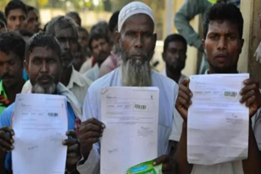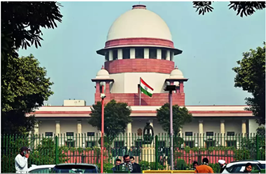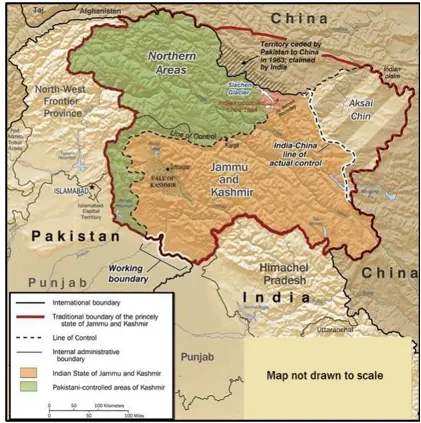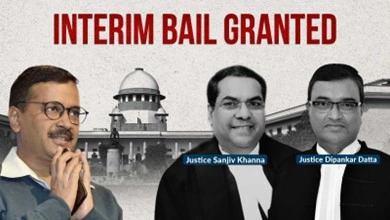Wednesday, 17th July 2024
National Quantum Mission: Why India has a lot of catching
Why in the news?
- In 2023, India launched the National Quantum Mission, making it one of the few countries with a dedicated program to harness quantum technologies.
- But despite having a strong research base in quantum science, India has a lot of catching up to do because India lags behind China and the US.
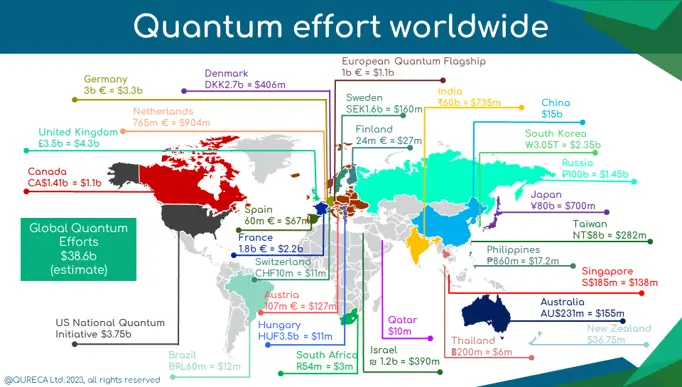
What is Quantum Technology?
- Quantum technology is a field of science and engineering that applies quantum mechanics principles to study matter and energy at the smallest scale.
- Quantum mechanics is the branch of physics that describes the behaviour of matter and energy at the atomic and subatomic level.
What are the advantages of Quantum Technology?
- Increased Computing Power: Quantum computers are significantly faster than classical computers and can solve complex problems currently beyond our reach.
- Improved Security: Quantum encryption techniques, based on quantum mechanics principles, are much more secure than traditional encryption methods.
- Faster Communication: Quantum communication networks can transmit information faster and more securely than traditional networks, offering the potential for unhackable communication.
- Enhanced AI: Quantum machine learning algorithms can enable more efficient and accurate training of Artificial Intelligence models.
- Better Sensing and Measurement: Quantum sensors can detect extremely small changes in the environment, making them useful in medical diagnostics, environmental monitoring, and geological exploration.
The principles behind quantum technology:
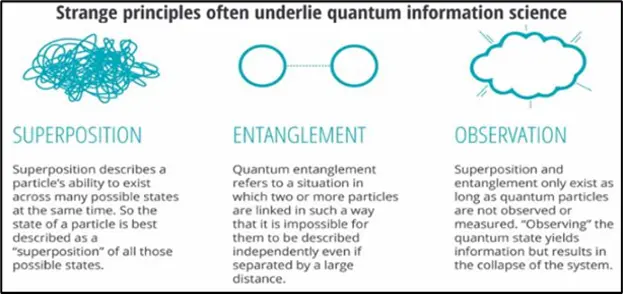
What are disadvantages of Quantum Technology:
- Expensive: Requires specialised equipment and materials, making it costlier than traditional technologies.
- Limited Applications: Currently useful mainly for specific applications such as cryptography, quantum computing, and quantum communication.
- Sensitivity to Environment: Highly sensitive to environmental interference like temperature changes, magnetic fields, and vibrations; qubits can easily lose their quantum properties, leading to errors in calculations.
- Limited Control:
- Difficult to control and manipulate quantum systems; quantum-powered AI could create unintended consequences.
- Reach conclusions that are unexpected or difficult to explain due to their fundamentally different operating principles compared to classical computing.
What is the National Quantum Mission?
- About:
- Implemented by the Department of Science & Technology (DST) under the Ministry of Science & Technology.
- Planned for 2023-2031, the mission aims to seed, nurture, and scale up scientific and industrial R&D, creating a vibrant and innovative ecosystem in Quantum Technology (QT).
- India becomes the seventh country to have a dedicated quantum mission, following the US, Austria, Finland, France, Canada, and China.
- Salient Features of NQM:
- Quantum Computers Development: Target developing intermediate-scale quantum computers with 50-100 physical qubits in 5 years and 50-1000 physical qubits in 8 years. Qubits, or ‘quantum bits,’ are the units of process in quantum computers.
- High Sensitivity Magnetometers: Development for precision timing (atomic clocks), communications, and navigation.
- Quantum Materials: Design and synthesis of materials such as superconductors, novel semiconductor structures, and topological materials for the fabrication of quantum devices.
- Secure Quantum Communications:
- Satellite-based secure quantum communications between ground stations over a range of 2000 km within India.
- Long-distance secure quantum communications with other countries.
- Inter-city quantum key distribution over 2000 km.
- Multi-node quantum network with quantum memories.
- Thematic Hubs (T-Hubs): Four T-Hubs to be set up in top academic and National R&D institutes focusing on:
- Quantum computation
- Quantum communication
- Quantum sensing and metrology
- Quantum materials and devices
- Significance:
- Accelerates QT-led economic growth, making India a leading nation in Quantum Technologies & Applications (QTA), impacting healthcare, diagnostics, defence, energy, and data security.
- Aims to indigenously build quantum-based computers capable of solving complex problems in a highly secure manner.
What is the progress of Quantum Technology in India?
- India is currently at the forefront of tapping the quantum revolution through massive investments in the field.
- National Mission on Quantum Technologies and Applications (NMQTA): The Union Budget 2020-21 proposed to spend ₹8,000 crore on this newly launched mission.
- National Mission on Interdisciplinary Cyber Physical Systems (NM-ICPS): ₹3,660 crore allocated for this mission.
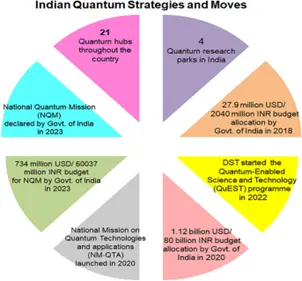
- India Lagging Behind Other Nations:
- Countries like China and the US have a significant lead in quantum technologies over India due to substantial investments, more professionals, higher publication rates, and numerous registered patents.
- India Still Remains in Competition:
- Research Leadership: Indian scientists excel in quantum communications and quantum sensing.
- Bridging the Gap: In computing and materials, the disparity is bridgeable.
- Graduate Students: India has over 82,000 graduate students in disciplines aligned with quantum technologies, more than China or the US.
Way Ahead for India:
- Quantum-Enabled Transition: Within a decade or two, quantum advancements could underpin a new economy, overcoming current technological limitations.
- Technology Partnerships: Collaborating in technology development can lead to early success, rapid economic progress, and access to advanced technologies.
- NQM’s Role: The National Quantum Mission needs to identify and nurture young talent, creating a dedicated cadre of quantum scientists.
Conclusion:
While there is significant ground to cover, the National Quantum Mission marks an important beginning, and India is not starting from scratch
Source: IE
Govt to Review Clean air Action Plan of Cities
Why in the news?
- Recently, the review of air quality improvement action plans of 131 cities is likely to be held by the Government this month as part of the Centre’s 100-day agenda.
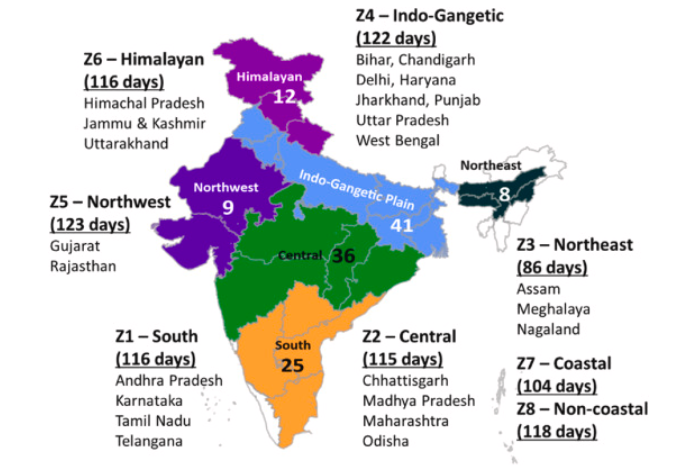
- Funds of Rs 1,165.48 crore have been released to 82 cities between 2019-20 and 2023-24, of which 51% or Rs 830.04 crore has been spent by states, the minutes of the meeting said.
About National Clean Air Programme (NCAP):
- National Clean Air Programme (NCAP) is a comprehensive initiative launched by the Government of India to tackle the pressing issue of air pollution across the country.
- Initiated in January 2019 by the Ministry of Environment, Forest and Climate Change (MoEFCC), NCAP aims to systematically reduce air pollution levels and improve air quality through a multi-pronged approach.
- Objectives:
- The primary objective of NCAP is to achieve a 40% reduction in particulate matter (PM2.5 and PM10) concentrations by 2026, taking 2017 as the base year.
- The program targets both short-term and long-term measures to mitigate air pollution across various sectors.
Key Features of National Clean Air Programme:
- City-Specific Plans:
- NCAP focuses on 131 non-attainment cities identified by the Central Pollution Control Board (CPCB), where air quality standards have consistently been exceeded.
- Each city has developed customised action plans that address local sources of pollution, such as vehicular emissions, industrial discharges, dust from construction activities, and waste burning.
- Monitoring and Enforcement:
- Strengthening the existing air quality monitoring network with the addition of more monitoring stations and sensors to provide real-time data.
- Enhancing enforcement of air quality regulations and ensuring strict compliance with emission norms.
- Public Awareness and Participation:
- Conducting awareness campaigns to educate citizens about the health impacts of air pollution and promoting community participation in pollution control activities.
- Encouraging the adoption of cleaner technologies and practices by industries, businesses, and households.
- Inter-Agency Coordination:
- Facilitating coordination between various government departments, including transport, urban development, agriculture, and power, to implement integrated pollution control measures.
- Establishing inter-ministerial task forces and committees to oversee the implementation and progress of the NCAP.
- Technological and Financial Support:
- Promoting the adoption of clean technologies through financial incentives and subsidies.
- Allocating funds to states and municipalities to support the implementation of their respective action plans.
- Research and Development:
- Encouraging scientific research to develop innovative solutions for air pollution control.
- Collaborating with academic institutions and research organisations to study the sources and health impacts of air pollution.
- PRANA (Portal for Regulation of Air-pollution in Non-Attainment Cities) is a portal for monitoring the implementation of NCAP.
Progress & Challenges of NCAP:
- Air Information Centers and Pollution Forecasting:
- Goal: Establish air information centres at central and regional levels by 2020.
- Status: Only the central PRANA portal by CPCB is functional.
- Goal: Implement air pollution forecasting systems in non-attainment cities by 2022.
- Status: Only Delhi has a functional system.
- Committee Setup and Utilisation of Funds:
- Committees: Proposed at various levels, but issues remain with functionality, transparency, and public information.
- Fund Utilisation:
- Of ₹1,253 crore allocated to 82 non-attainment cities, only ₹498 crore (40%) was used.
- Of ₹9,610 crore allocated to 49 million-plus cities, ₹5,909 crore (62%) was utilised, indicating significant underutilization.
- Monitoring Stations:
- Goal: Increase manual monitoring stations under NAMP from 703 to 1,500 by 2024.
- Status: Only 931 manual stations operational, showing a critical shortfall.
- Continuous Ambient Air Quality Monitoring Stations (CAAQMS):
- Goal: Establish 150 stations.
- Status: 531 stations are operational, indicating very good progress.
- Rural Monitoring Network:
- Current: 26 manual stations.
- Goal: Set up 100 stations by 2024.
- Status: Full realisation of this goal seems difficult.
- Source Apportionment:
- Only 44 out of 131 non-attainment cities conducted source apportionment studies.
- Data Availability and Compliance:
- Data Availability: 227 cities had over 75% data availability days in 2023, with 85 under NCAP and 142 not covered by NCAP.
- PM10 Levels: 78 NCAP cities and 118 non-NCAP cities exceeded National Ambient Air Quality Standards (NAAQS) for PM10.
Govt to Review Clean Air Action Plan of Cities:
- The upcoming meeting will focus on evaluating actions in dust control, electric vehicle charging stations, public transport improvement, waste management, and urban greening.
- The Ministry's review aims to ensure prompt fund utilisation, especially amidst scrutiny by the National Green Tribunal for unused funds.
- Submissions indicate funds were diverted to non-essential projects like football grounds, water fountains, and desludging machines.
Initiatives Taken for Controlling Air Pollution:
- System of Air Quality and Weather Forecasting and Research (SAFAR) Portal:
- Provides real-time information on air quality and weather forecasts.
- Air Quality Index (AQI):
- Developed for eight pollutants: PM2.5, PM10, Ammonia, Lead, nitrogen oxides, sulphur dioxide, ozone, and carbon monoxide.
- Helps in understanding and communicating air quality levels to the public.
- Graded Response Action Plan (for Delhi):
- Aims to control air pollution during different levels of severity.
- Implements measures like banning diesel generators, construction activities, etc., during severe pollution episodes.
- Initiatives for Reducing Vehicular Pollution:
- BS-VI Vehicles: Introduction of Bharat Stage VI emission norms to reduce vehicle emissions.
- Push for Electric Vehicles (EVs): Incentives and policies to promote adoption of electric vehicles.
- Odd-Even Policy: Implemented as an emergency measure in Delhi to reduce traffic and pollution during peak periods.
- New Commission for Air Quality Management:
- Established to coordinate efforts and enforce measures to improve air quality across India.
- Subsidy for Turbo Happy Seeder (THS) Machine:
- Provides subsidies to farmers for adopting Turbo Happy Seeder machines to reduce stubble burning, a major contributor to air pollution.
- National Air Quality Monitoring Programme (NAMP):
- Monitors four air pollutants (SO2, NO2, PM10, and PM2.5) regularly across all locations.
- Provides data for informed decision-making and policy formulation.
|
UPSC Civil Services Examination Previous Year Question (PYQ) Prelims Q:1 In the cities of our country, which among the following atmospheric gases are normally considered in calculating the value of the Air Quality Index? (2016)
Select the correct answer using the code given below:
Ans: (b)
Mains Q:1 Describe the key points of the revised Global Air Quality Guidelines (AQGs) recently released by the World Health Organisation (WHO). How are these different from its last update in 2005? What changes in India’s National Clean Air Programme are required to achieve revised standards? (2021) |
Source: IE
Humanising Citizenship Law in India
Why in the news?
- The Supreme Court of India recently declared Md Rahim Ali, an Assam resident, a citizen of India, overturning the decision of a Foreigners' Tribunal (FT) that had declared him a foreigner due to minor discrepancies in spellings and dates in his documents.
What are Foreigners' Tribunals (FTs)?
- Nature: Quasi-judicial bodies entrusted with determining the citizenship status of individuals accused of being or labelled as foreigners.
- Establishment: Formed as per the Foreigners' Act 1946 and the Foreigners' Tribunal Order 1964.
- Historical Context: The Foreigners Act 1946 is a colonial legislation that preceded the Constitution of India. Post-independence, FTs were established in 1964 by an executive order of the Home Ministry.
- Constitutional Provision: Under Article 323B (inserted by the Constitution [42nd Amendment] Act 1976), appropriate legislatures may establish tribunals by law.
Why are FTs under Criticism in Assam?
- Doubtful Voters: About 3 lakh people were declared Doubtful Voters in 1997 without any inquiry or notice, excluding them from the Assam National Register of Citizens (NRC).
- Notice Issues: The Foreigners' Tribunal Order 1964 mandates that notices must mention the "main grounds," yet notices generally lack such details.
- Burden of Proof: The Foreigners Act 1946 places the burden of proof on the person alleged to be a foreigner. As of March 2019, 1.17 lakh people were declared foreigners without knowing the specific charges against them.
- SC Judgement Impact: The recent Supreme Court judgement could positively impact pending cases by requiring the state to share the material on which allegations are founded, adhering to the principle of natural justice.
How the SC’s Verdict Humanised Citizenship Law in India?
- Burden of Proof: The Supreme Court held that the burden of proof under the Foreigners Act must be discharged only after the state shares the material on which the allegation is founded.
- Natural Justice: Emphasised the classic rule of natural justice—no one shall be condemned unheard.
- Minor Discrepancies: The judgement ensures that minor discrepancies in documents do not result in loss of citizenship, alleviating anxieties related to the CAA 2019 and the proposed nationwide NRC.
The Citizenship (Amendment) Act (CAA) 2019:
- Objective: Amends the definition of illegal immigrants for Hindu, Sikh, Parsi, Buddhist, Jain, and Christian (but not Muslim) immigrants from Pakistan, Afghanistan, and Bangladesh, granting them fast-track Indian citizenship in five years (previously 11 years).
- Provisions: Also provides for cancellation of Overseas Citizen of India (OCI) registration if the OCI cardholder violates any provision of the Citizenship Act or any other law.
- Eligibility: Applies to those who sought shelter in India due to religious persecution, with a cut-off date for citizenship being December 31, 2014.
- Exclusions: Does not apply to areas covered by the Constitution's sixth schedule (autonomous tribal regions in Assam, Meghalaya, Tripura, and Mizoram) or states with an inner-line permit regime (Arunachal Pradesh, Nagaland, and Mizoram).
National Register of Citizens (NRC):
- Purpose: An official record of legal Indian citizens, mandated by the 2003 amendment of the Citizenship Act, 1955, to identify and deport illegal immigrants.
- Implementation: So far, the NRC has been maintained only for Assam.
- Assam NRC: Updated following a writ petition demanding the deletion of illegal migrants' names from voter lists. The SC ordered the update in 2014, and the final NRC was released on August 31, 2019, excluding over 1.9 million applicants.
- Appeals Process: Those excluded can file an appeal with the Foreigners Tribunal, which has the sole authority to declare a person a foreigner.
Termination of Indian Citizenship:
- Renunciation
- Process: An Indian citizen who is also a national of another country can renounce Indian citizenship by making a formal declaration.
- Effect: Renunciation by a male citizen leads to his minor children also losing Indian citizenship. They can reclaim it within a year of adulthood by declaring their intention.
- Termination
- Criteria: Indian citizenship ends if a citizen voluntarily acquires citizenship of another country.
- Deprivation
- Authority: The Indian government can strip a person of citizenship under specific circumstances.
- Applicability: This applies to individuals who acquired citizenship through registration, naturalisation, or under Article 5 Clause (c) of the Constitution (residents for five years before the Constitution's commencement).
Conclusion
The Supreme Court's recent judgement underscores the importance of humanising citizenship laws by ensuring due process and protection against arbitrary deprivation of citizenship. This has broader implications for the implementation of the NRC and the CAA, emphasising fairness and justice in administrative and judicial processes.
|
UPSC Civil Services Examination, Previous Year Questions (PYQs) Prelims Q:1 With reference to India, consider the following statements: (2021)
Which of the statements given above is/are correct? (a) 1 only (b) 2 only (c) 1 and 3 (d) 2 and 3 Ans: (a) |
Source: IE
Centre reconstitutes NITI Aayog
Why in the news?
- The Centre has reconstituted NITI Aayog with 15 Union Ministers, including those from NDA allies, and four full-time members, following recent changes in the council of ministers.

National Institution for Transforming India (NITI) Aayog:
- About:
- Established via a Union Cabinet resolution on January 1, 2015, replacing the Planning Commission founded in 1950.
- Premier policy thinks tank of the Government of India, providing policy inputs and fostering cooperative federalism.
- Composition:
- Chairperson: Prime Minister of India.
- Vice Chairperson: Appointed by the PM, holds the rank of Cabinet Minister.
- Full-Time Members: Hold rank of Minister of State.
- Part-Time Members: Maximum of 2.
- Ex-Officio Members: Up to 4 Union Council of Ministers nominees appointed by the PM.
- CEO: Appointed by the PM, holds the rank of Secretary to the Government of India.
- Special Invitees: Experts with domain knowledge nominated by the PM.
Governing Council of NITI Aayog:
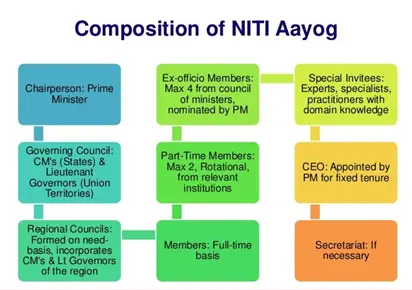
Key Objectives of NITI Aayog:
- Foster Cooperative Federalism:
- Support States through structured initiatives to strengthen the nation.
- Formulate Plans at Village Level:
- Develop mechanisms to create credible plans at the grassroots level and integrate them into higher levels of governance.
- Incorporate National Security in Economic Strategy:
- Ensure economic policies reflect national security interests in specified areas.
- Focus on Socially Vulnerable Sections:
- Address disparities to ensure equitable benefits from economic growth.
- Facilitate Partnerships and Advice:
- Encourage collaborations between stakeholders, national and international think tanks, and educational institutions.
- Promote Knowledge and Innovation:
- Establish a support system for innovation and entrepreneurship through collaboration with experts and partners.
- Resolve Inter-Sectoral Issues:
- Provide a platform for resolving cross-sectoral and inter-departmental challenges to expedite development initiatives.
- Maintain a Resource Centre for Governance Research:
- Act as a repository for research on good governance and sustainable development practices, facilitating their dissemination.
|
Two Hubs of NITI Aayog: Team India Hub:
Knowledge and Innovation Hub:
|
Core Principles of NITI Aayog:
- Antyodaya:
- Prioritises the service and upliftment of the poor, marginalised, and downtrodden, based on Pandit Deendayal Upadhyay’s idea of ‘Antyodaya’.
- Inclusion:
- Empowers vulnerable and marginalised sections, addressing identity-based inequalities across genders, regions, religions, castes, and classes.
- Village:
- Integrates villages into the development process, leveraging their vitality and energy as the bedrock of India's ethos, culture, and sustenance.
- Demographic Dividend:
- Harnesses India’s greatest asset, its people, by focusing on education and skilling, and empowering them through productive livelihood opportunities.
- People’s Participation:
- Transforms the developmental process into a people-driven one, making an awakened and participative citizenry the driver of good governance.
- Governance:
- Nurtures an open, transparent, accountable, proactive, and purposeful style of governance, transitioning focus from outlay to output to outcome.
- Sustainability:
- Maintains sustainability at the core of planning and development, building on India’s ancient tradition of respect for the environment.
Concerns with NITI Aayog:
- Policy Prioritisation:
- NITI Aayog must prioritise its 13 objectives, distinguishing between policy, planning, and strategy effectively.
- Financial Autonomy:
- To gain trust comparable to the Planning Commission, NITI Aayog requires financial autonomy, particularly in revenue and capital expenditures, to address infrastructural deficits effectively.
Major Initiatives by NITI Aayog:
- SDG India Index: Tracks progress on Sustainable Development Goals.
- Atal Innovation Mission: Promotes innovation and entrepreneurship.
- SATH Project: Enhances governance in health and education sectors.
- School Education Quality Index: Evaluates educational outcomes in states.
- Health Index: Ranks states based on health outcomes.
- Agriculture Reform Index: Evaluates agricultural marketing reforms.
- India Innovation Index: Ranks states on innovation capacity.
- Good Governance Index: Assesses state governance performance.
- Women Entrepreneurship Platform (WEP): Supports women entrepreneurs.
- Strategy for New India at 75: Outlines development strategy for India by 2022-23.
- 'Methanol Economy' Programme: Promotes methanol as an alternative fuel.
- e-AMRIT Portal: Provides information on electric vehicles.
Reconstitution of NITI Aayog:
- Expanded special invitees from 5 to 11, including 5 ministers from BJP's allied parties.
- Key officials retained include Prime Minister Narendra Modi as Chairperson and economist Suman K Bery as Vice Chairperson.
- Full-time members include scientists and economists like V K Saraswat and Ramesh Chand.
- Ex-officio members appointed include Union Ministers Rajnath Singh, Amit Shah, Shivraj Singh Chouhan, and Nirmala Sitharaman.
Source: IE
What constitutes a Money Bill
Why in the news?
- The Supreme Court has agreed to consider petitions challenging the government's use of the "Money Bill route" to pass contentious legislation in Parliament.
- The issue of which Bills can be designated as Money Bills was referred to a seven-judge Bench in November 2019 by a five-judge Bench led by then CJI Ranjan Gogoi in the case of Rojer Mathew vs South Indian Bank Ltd.
- In October 2023, CJI Chandrachud announced that the seven-judge Bench would be established soon.
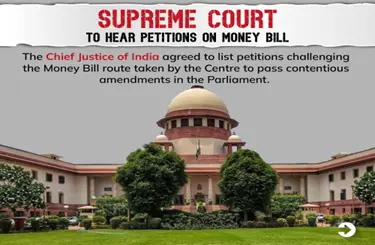
About the Money Bill:
- Article 110: Defines a money Bill as one containing provision dealing with taxes, regulation of the government’s borrowing of money, and expenditure or receipt of money from the Consolidated Fund of India, among others.
- Article 109: Delineates the procedure for the passage of such a Bill and confers an overriding authority on the Lok Sabha in the passage of money Bills.
- Introduction: A Money Bill shall be introduced only in Lok Sabha and, upon passage, transmitted to Rajya Sabha for its recommendations.
- Rajya Sabha: Must revert within 14 days, but it is up to Lok Sabha to accept or reject any or all of its recommendations.
- Speaker's Certification: The Speaker certifies a Bill as a Money Bill, and the Speaker’s decision is final.
- Article 110(3): If any question arises whether a Bill is a Money Bill or not, the decision of the Speaker of the House of the People thereon shall be final.
- Recent Usage: Over the last seven years, the government has introduced multiple legislations through the money Bill route, the most notable of which are the Aadhaar Act, 2016, and the Finance Act, 2017.
Difference between money Bills and financial Bills:
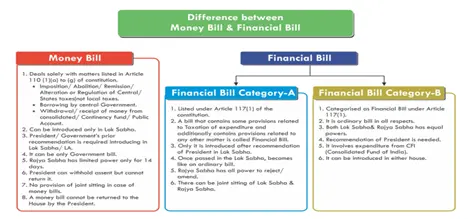
What Constitutes a Money Bill: Important Cases in the Supreme Court
- Challenge to Aadhaar Act:
- September 2018: The Supreme Court upheld the constitutionality of the Aadhaar Act by a 4-1 majority.
- Petitioners' Argument: Claimed it was improperly passed as a Money Bill, including unrelated provisions.
- Majority View: Justice Ashok Bhushan supported the Act's primary aim to provide subsidies and benefits, justifying its passage as a Money Bill.
- Dissenting View: Justice D.Y. Chandrachud called it an abuse of the constitutional process, undermining the Rajya Sabha's role in lawmaking.
- Finance Act, 2017:
- Amendments: The Act amended various laws and allowed the government to set rules for Tribunal members' service conditions.
- Petitioners' Argument: Argued it should be struck down for including unrelated provisions.
- November 2019: A five-judge Bench invalidated the Tribunal Rules for infringing on judicial independence but referred the Money Bill issue to a larger seven-judge Bench.
- Court's Observation: The Aadhaar case did not clearly define a valid Money Bill.
- Since 2019:
- Pending Review: The court has avoided addressing the Money Bill issue in several cases due to the pending seven-judge Bench review.
- Notable Cases: Challenges to the Enforcement Directorate's wide powers under the PMLA (Finance Act, 2018) and the Centre's Electoral Bond scheme, both facilitated through the Money Bill route.
|
UPSC Civil Services Exam Previous Year Questions (PYQs) Prelims Q:1 Regarding Money Bill, which of the following statements is not correct? (2018)
Answer: C
Q:2 Consider the following statements: (2015)
Which of the statements given above is/are correct?
Answer: B
Q:3 What will follow if a Money Bill is substantially amended by the Rajya Sabha?(2013)
Answer: A
Q:4 A deadlock between the Lok Sabha and the Rajya Sabha calls for a joint sitting of the Parliament during the passage of (2012)
Select the correct answer using codes the given below:
Answer: A |
Source: IE
FishMIP Initiative
Why in the news?
- The Ecosystem Model Intercomparison Project (FishMIP) report indicates a projected decline in exploitable fish biomass by over 10%, particularly under high-emissions scenarios, by mid-century for many global regions.

About FishMIP Initiative:
- Launch Year: 2013
- Purpose: To provide industry and governments with knowledge supporting effective planning for adaptive and resilient seafood sectors in the context of climate change.
- Network: Comprises over 100 marine ecosystem modellers and researchers worldwide.
- Collaboration: Partnered with the Food and Agriculture Organization (FAO) to assess long-term climate change impacts on marine ecosystems and fisheries using advanced numerical models.
- FishMIP 2.0 (2024): Established to enhance the reliability of modelling projections and address broader policy-related questions pertinent to food security and marine resource management, with climate change as the central theme.
Key Facts about the Food and Agriculture Organization (FAO):
- Role: A specialised agency of the United Nations, leading international efforts to defeat hunger and improve nutrition and food security.
- Goal: Achieving food security for all, ensuring regular access to high-quality food for active and healthy lives.
- Members: 195 members, including 194 countries and the European Union.
- Sister Bodies: World Food Programme (WFP) and the International Fund for Agricultural Development (IFAD).
- Published Reports:
- The State of the World's Forests (SOFO)
- The State of World Fisheries and Aquaculture (SOFIA)
- The State of Agricultural Commodity Markets (SOCO)
- The State of Food Security and Nutrition in the World (SOFI)
- Headquarters: Rome, Italy.
Source: FAO
U-WIN Portal
Why in the news?
- The U-WIN portal, modelled after the Covid-19 vaccine management system Co-WIN, is slated for a nationwide launch by the end of August.
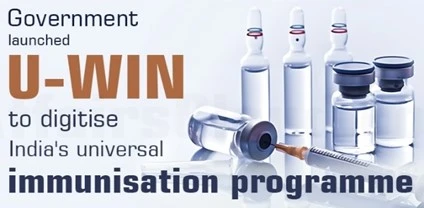
About U-WIN Portal:
- Purpose: To maintain an electronic registry of routine immunizations.
- Current Status: In pilot mode across all states and Union Territories, except West Bengal.
- Coverage: Captures every vaccination event for pregnant women and children under the Universal Immunization Programme (UIP).
- Objective: Ensures timely administration of vaccine doses by digitally recording every vaccination event for pregnant women and children aged 0-5 years.
Features:
- e-Vaccination Certificate:
- Generates a QR-based, digitally verifiable e-vaccination certificate similar to the Covid-19 vaccination certificate.
- Accessible anytime by citizens through a single click.
- Centralised Information:
- Serves as the single source of information for immunisation services.
- Records pregnancy details, newborn registration, immunisation at birth, vaccination status, and delivery outcomes in real-time.
- Self-Registration:
- Citizens can self-register for vaccinations via the U-WIN web portal or Android mobile application.
- Allows selection of preferred vaccination centres and scheduling of appointments.
- Automated Alerts:
- Sends automated SMS alerts for registration confirmations, administered doses, and upcoming dose reminders.
- Ensures timely and age-appropriate vaccinations.
- ABHA IDs Creation:
- Facilitates the creation of Ayushman Bharat Health Account (ABHA) IDs for comprehensive health record maintenance.
- Support for Frontline Workers:
- Enables frontline workers to digitally record all vaccination events for children and pregnant women.
- Ensures complete, accurate, and easy record maintenance.
Source: BS
International Civil Aviation Organization (ICAO)
Why in the news?
- India is set to host the second Asia Pacific (APAC) ministerial conference on civil aviation, which will be jointly organised by the Indian government and the International Civil Aviation Organization (ICAO).
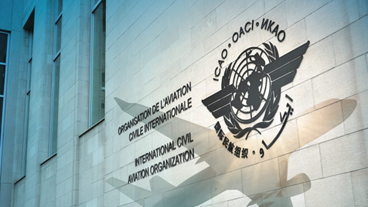
About International Civil Aviation Organization (ICAO):
- Nature: Intergovernmental specialised agency of the United Nations (UN).
- Establishment: Founded in 1947 by the Convention on International Civil Aviation (1944), commonly known as the Chicago Convention.
- Headquarters: Montreal, Canada.
Objectives:
- Promote the safe and orderly development of international civil aviation worldwide.
- Set standards and regulations for aviation safety, security, efficiency, regularity, and environmental protection.
- Serve as a forum for cooperation in all fields of civil aviation among its 193 member states.
- Promote regional and international agreements to liberalise aviation markets and establish legal standards.
Component Bodies:
- Assembly:
- It is composed of delegates from all member countries.
- Meets every three years.
- Council:
- Consists of representatives from 36 member states, elected by and responsible to the Assembly.
- Sits in continuous session at ICAO headquarters.
- Air Navigation Commission:
- Appointed by the Council to address technical matters.
- Standing Committees:
- Include a Committee on Joint Support of Air Navigation Services and a Finance Committee.
Secretariat:
- Headed by a Secretary-General selected by the Council for a three-year term.
Source: ET
Yellow-Legged Buttonquail
Why in the news?
- The Yellow-Legged Buttonquail was recently spotted in urban areas of Bopal-Ghuma in Ahmedabad city.

About Yellow-Legged Buttonquail:
- Family: Turnicidae
- Scientific Name: Turnix tanki
Distribution:
- Native Range: Indian subcontinent, East Asia, and Southeast Asia.
- Subspecies:
- T. t. tanki: Found in Pakistan, India, Nepal, and the Andaman and Nicobar Islands.
- T. t. blanfordii: Found in Myanmar, Indochina, and eastern China.
- Migratory Habits: Migrates to the Korean Peninsula and parts of southeast Russia.
Features:
- Size:
- Length: Approximately 16 to 18 centimetres.
- Weight: Around 50 to 60 grams.
- Compair: Female birds are larger than males.
- Appearance:
- Structure: Compact and stocky with a plump, rounded shape.
- Colours: Vibrant colours including shades of brown, grey, and black for camouflage.
- Upper body: Predominantly brown with intricate patterns.
- Underparts: Lighter, often displaying a mix of grey and white tones.
- Distinctive Trait: Bright yellow legs.
- Behaviour:
- Ground-dwelling bird.
- Prefers running to flying when threatened.
Conservation Status:
- IUCN Red List: Least Concern
Source: TOI
Big Brother to Brother, A Nepal-India Reset
Context:
- Since 2015, the leadership of Prime Ministers Narendra Modi of India and Khadga Prasad Oli of Nepal has marked a period of significant turbulence in bilateral relations.
- This era has been defined by diplomatic strains, economic blockades, and geopolitical manoeuvres, leaving a lasting impact on India-Nepal ties.
- However, the current political landscape offers an opportunity to recalibrate and stabilise these relations, with both leaders once again heading their respective governments.

India-Nepal Bilateral Turbulence:
- Nepal's New Constitution and India's Reaction:
- In 2015, Nepal adopted a new Constitution, aiming to solidify its transition to a federal democratic republic post a decade-long civil war.
- India expressed concerns over specific provisions, particularly regarding the representation and rights of the Madhesi community near the India-Nepal border.
- The Blockade:
- India imposed an unofficial blockade on Nepal in response to the new Constitution, severely restricting essential supplies like fuel, medicine, and food.
- Lasting nearly six months from late September 2015, the blockade exacerbated economic hardships and daily life challenges in Nepal, heavily reliant on Indian imports.
- While officially attributed to protests by Madhesi activists, many in Nepal and international observers believed it was politically motivated to pressure Kathmandu for constitutional amendments.
- Political and Economic Implications of the Blockade:
- The blockade strained diplomatic ties and had profound political and economic repercussions.
- It exacerbated Nepal's challenges post the devastating April 2015 earthquake, leading to heightened nationalist sentiments and a strategic shift in Nepal's foreign policy, notably towards China.
- Prime Minister Khadga Prasad Oli utilised the crisis to strengthen ties with China, influencing Nepal's political landscape.
- Diplomatic Efforts to Restore Ties and Unresolved Issues:
- Following the blockade's lifting in early 2016, efforts focused on rebuilding trust and cooperation through high-level visits and diplomatic engagements.
- However, the blockade's legacy continued to cast a shadow over bilateral relations, highlighting complex issues of mutual dependence, sovereignty, and geopolitical strategies.
- Unresolved grievances, particularly those of the Madhesi community, remained contentious, impacting Nepal's internal stability and its relationship with India
Post-Blockade Diplomatic and Political Strains between India and Nepal
- Territorial Disputes and Tensions
- Territorial Claims: In October 2019, India released an updated political map that included the disputed Limpiadora-Kalapani region, claimed by Nepal.
- Nepal's Response: Nepal's Parliament amended its Constitution to formally include the Limpiadora-Kalapani region in its national map, heightening tensions.
- Escalated Dispute: Nepal's unilateral action exacerbated the dispute, revealing deep-seated mistrust and sensitivity surrounding border issues.
- Increased Indian Involvement in Nepali Politics:
- Modes of Involvement: India exerted political pressure, engaged in diplomatic manoeuvres, and supported specific political factions within Nepal.
- Perceptions in Nepal: Many in Nepal viewed India's actions as interference in its internal affairs, contrary to the principles of non-interference and mutual respect under the Panchsheel doctrine.
- Cultural Influence: The RSS and BJP advocated a Hindutva agenda in Nepal, seeking closer alignment with Indian cultural and political norms.
- Perceived Overreach and Power Dynamics:
- Public Perception: Nepalis perceived India’s actions during and after the blockade as punitive and coercive, deepening mistrust.
- Political Dynamics: Under Prime Minister Pushpa Kamal Dahal ('Prachanda'), India-Nepal relations were strained as Dahal faced accusations of yielding to Indian pressures.
- Contentious Issues: During Dahal's tenure, sensitive topics such as air routes, territorial disputes, and the Eminent Persons’ Group report remained unresolved during visits to India.
Recent Developments:
- Arun-3 Hydro Electric Project
- Investment Approval: In 2019, India approved ₹1236 crore for the Arun-3 hydro project.
- Project Details: Located on the Arun River in Eastern Nepal, it is a 900 MW run-of-river project.
- Execution: Operates under the Build Own Operate and Transfer (BOOT) basis with a 30-year tenure, including a five-year construction phase.
- International Centre for Buddhist Culture and Heritage
- Inauguration: During the visit of the Indian Prime Minister, the 'shilanyas' ceremony launched the construction of the India International Centre for Buddhist Culture and Heritage in Lumbini Monastic Zone.
- Purpose: A world-class facility aimed at hosting pilgrims and tourists, emphasising Buddhism's spiritual essence.
- Target Audience: Designed to cater to scholars and Buddhist pilgrims globally visiting Lumbini.
- Hydropower Projects
- Arun-4 Project: Agreements were signed between Satluj Jal Vidyut Nigam (SJVN) Ltd. and Nepal Electricity Authority (NEA) for the development of the 490.2 MW Arun-4 hydropower project.
- West Seti Project: India invited Nepali companies to invest in the West Seti hydropower project, demonstrating mutual cooperation in energy infrastructure.
- Educational Initiatives:
- IIT Satellite Campus: India proposed establishing a satellite campus of the Indian Institute of Technology (IIT) in Rupandehi, highlighting educational collaboration.
- Draft MOUs: Draft memorandum of understanding were exchanged between Indian and Nepali universities to enhance educational partnerships.
- Infrastructure Projects:
- Pancheshwar Multipurpose Project: Discussions continued on the Pancheshwar Project, vital under the Mahakali Treaty, and the West Seti Hydropower Project, projecting a capacity of 1,200 MW.
- Cross-border Rail Link: Extending the operational 35 km rail link from Jayanagar (Bihar) to Kurtha (Nepal), with plans for further expansion to Bijalpura and Bardibas.
- Energy and Connectivity Initiatives:
- Double Circuit Transmission Line: A 90 km, 132 kV double circuit transmission line connecting Tila (Solukhumbu) to Mirchaiya (Siraha), enhancing cross-border energy connectivity.
- Multilateral Cooperation: Agreements included technical cooperation in railways, Nepal’s induction into the International Solar Alliance, and ensuring petroleum product supplies.
Challenges:
- Territorial Disputes
- Kalapani Issue: Unresolved territorial disputes, including Kalapani, remain contentious, impacting bilateral relations despite historical demarcation efforts.
- Treaty and Economic Issues
- 1950 Treaty of Peace and Friendship: Viewed by Nepal as unequal, necessitating revisiting to align with contemporary diplomatic norms and bilateral cooperation.
- Economic and Monetary Concerns
- Demonetisation Impact: Nepal faced challenges post-2016 Indian demonetisation, affecting Nepali nationals holding Indian currency and unresolved issues with the Nepal Rastra Bank.
- Geopolitical Shifts
- China’s Influence: Increasing Chinese investments in Nepal, especially under the Belt and Road Initiative, impacting regional dynamics and Nepal’s strategic autonomy.
- Security and Trust
- Border Security: Challenges in border security pose threats, exploited by insurgent groups and affecting regional stability and trust between India and Nepal.
Way Forward:
- Diplomatic Dialogue
- Territorial Dispute Resolution: Prioritise diplomatic channels and adherence to international law for resolving territorial disputes, learning from successful models like India-Bangladesh.
- Strengthening Relations
- People-to-People Engagement: Enhance cultural and educational exchanges to foster mutual understanding and trust.
- Economic Integration
- Trade and Investment: Strengthen economic ties through robust trade agreements, investment promotion, and collaborative infrastructure projects.
- Mutual Respect and Cooperation
- Policy Alignment: Uphold principles of mutual respect, non-interference, and inclusive development, supporting Nepal’s sovereignty and stability.
- Strategic Partnerships
- Regional Connectivity: Expand cross-border connectivity and energy partnerships, benefiting both nations economically and strategically.
|
UPSC Civil Services Exam Previous Year Questions (PYQs) Prelims: Q:1 Consider the following statements: (2020)
Which of the statements given above is/are correct?
Answer: B
Q:2 Consider the following pairs: (2016) Community In the affairs of
Which of the pairs given above is/are correctly matched?
Answer: C Mains: Q:1 ‘The long-sustained image of India as a leader of the oppressed and marginalised nations has disappeared on account of its newfound role in the emerging global order.’ Elaborate. (2019) |
Source: TH
Share the article
Edukemy’s Current Affairs Quiz is published with multiple choice questions for UPSC exams
MCQ
Get Latest Updates on Offers, Event dates, and free Mentorship sessions.

Get in touch with our Expert Academic Counsellors 👋
FAQs
UPSC Daily Current Affairs focuses on learning current events on a daily basis. An aspirant needs to study regular and updated information about current events, news, and relevant topics that are important for UPSC aspirants. It covers national and international affairs, government policies, socio-economic issues, science and technology advancements, and more.
UPSC Daily Current Affairs provides aspirants with a concise and comprehensive overview of the latest happenings and developments across various fields. It helps aspirants stay updated with current affairs and provides them with valuable insights and analysis, which are essential for answering questions in the UPSC examinations. It enhances their knowledge, analytical skills, and ability to connect current affairs with the UPSC syllabus.
UPSC Daily Current Affairs covers a wide range of topics, including politics, economics, science and technology, environment, social issues, governance, international relations, and more. It offers news summaries, in-depth analyses, editorials, opinion pieces, and relevant study materials. It also provides practice questions and quizzes to help aspirants test their understanding of current affairs.
Edukemy's UPSC Daily Current Affairs can be accessed through:
- UPSC Daily Current Affairs can be accessed through Current Affairs tab at the top of the Main Page of Edukemy.
- Edukemy Mobile app: The Daily Current Affairs can also be access through Edukemy Mobile App.
- Social media: Follow Edukemy’s official social media accounts or pages that provide UPSC Daily Current Affairs updates, including Facebook, Twitter, or Telegram channels.

